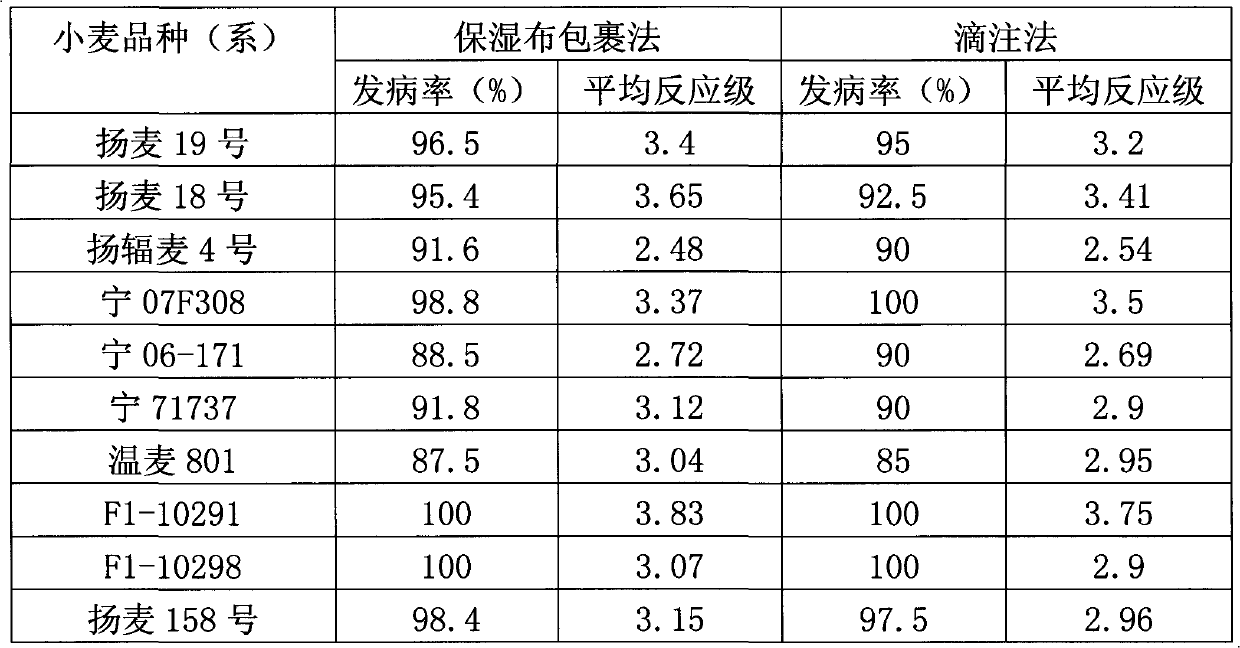Method for artificially inducing field wheat scab
A technology for scab and scab fungus, which is applied to the field of artificial inoculation inducing wheat scab in the field, can solve the problems of high cost of spray moisturizing facilities, labor costs, etc., so as to improve the induction effect of artificial inoculation, and improve the environmental humidity and temperature. balanced effect
- Summary
- Abstract
- Description
- Claims
- Application Information
AI Technical Summary
Problems solved by technology
Method used
Image
Examples
Embodiment 1
[0022] Embodiment 1: (the method for artificially inducing field wheat scab)
[0023] The method proceeds as follows:
[0024] (1) Cultivation of Gibberella zeae (Schw.) Petch conidia: select Gibberella zeae (Schw.) Petch strain ACCC31055 as the strain; cultivate and activate the strain on potato medium, then transfer to mung bean soup for cultivation After vibrating culture at 28°C and 280 rev / min for 7 days and filtering with gauze to obtain the filtrate, add sterile water to the liquid and observe under a microscope until the content of conidia in the liquid is 10 7 pcs / ml, reserve; among them,
[0025] The potato medium formula is: 200 grams of potatoes, 20 grams of sucrose, 17 grams of agar and 1000 ml of water; the preparation method is: wash the potatoes, peel them, shred them, add 500 ml of water and boil for 15 minutes, filter to obtain potato juice Add agar to 500ml of water, cook until the agar dissolves, filter to obtain agar solution; mix potato juice and agar s...
Embodiment 2
[0038] Embodiment 2: (the method for artificially inducing field barley scab)
[0039] In this example, in step (2), the filtrate of step (1), 5% water-retaining agent polyshuibao, 10% surfactant XB804 and sterile water are used in a ratio of 10% by weight: 5%: 5%: 80%. mixed to produce conidia with a content of 10 6 Individual / ml, polyhydric retention content 0.25%, XB804 content 0.5% scab inoculum of wheat class; The used barley variety of step (4) is No. 3 of Zhepi; Step (5) investigation time is 25 days after inoculation, The incidence rate of head blight in barley Zhepi No. 3 was 92.5%, and the average reaction grade was 3.28. All the other steps are the same as in Example 1.
Embodiment 3
[0040] Embodiment 3: (the method for artificially inducing field wheat scab)
[0041] In this example, in step (2), the filtrate of step (1), 5% water-retaining agent polyshuibao, 10% surfactant XB804 and sterile water are 0.01% by weight: 0.1%: 10%: 89.89% mixed to produce conidia with a content of 10 4 The inoculum of wheat class Fusarium rubella of individual / ml, polywater retention content 0.05%, XB804 content 0.025%; The wheat variety used in step (4) is Yangmai 158; The investigation time of step (5) is 22 days after inoculation, barley The incidence rate of scab in Zhepi 3 was 95%, and the average reaction grade was 2.76. All the other steps are the same as in Example 1.
[0042] In order to clarify the induction effect of the method of the present invention for artificially inducing wheat head blight in the field, the applicant conducted the following experiments.
PUM
 Login to View More
Login to View More Abstract
Description
Claims
Application Information
 Login to View More
Login to View More - R&D
- Intellectual Property
- Life Sciences
- Materials
- Tech Scout
- Unparalleled Data Quality
- Higher Quality Content
- 60% Fewer Hallucinations
Browse by: Latest US Patents, China's latest patents, Technical Efficacy Thesaurus, Application Domain, Technology Topic, Popular Technical Reports.
© 2025 PatSnap. All rights reserved.Legal|Privacy policy|Modern Slavery Act Transparency Statement|Sitemap|About US| Contact US: help@patsnap.com



